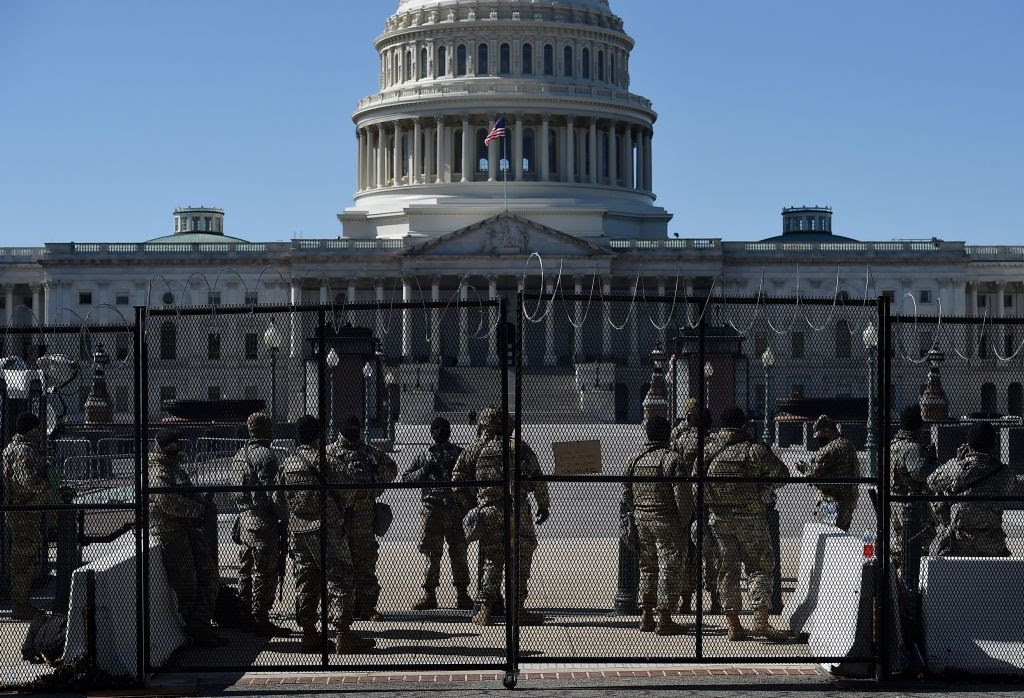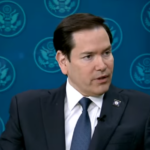
Gästskribent
A Storm Over the American Republic

The atmosphere in the United States remains poisonous. Critics claim that stoking in the public is being done on purpose — to create a false narrative that not only is Trump supposedly a ”threat to democracy,” but that his more than 74 million supporters are, too. Pictured: Members of the National Guard at a checkpoint on Capitol Hill on March 5, 2021, in Washington, DC. (Photo by Olivier Douliery/AFP via Getty Images)
January 20, 2021. President Joe Biden is sworn in as the 46th president of the United States. The scene, however, is devoid of any human presence. The streets of Washington DC are empty. People had been urged to stay at home and Americans throughout the rest of the country asked not to come. The city is under the protection of 25,000 members of the National Guard, heavily armed. High barriers topped with razor wire surround the Capitol area. In the streets planned for the new president’s ”parade”, barriers separate the sidewalks from the roadway. The only people visible are men in uniform carrying rifles. A day that is usually a day of celebration in the United States is, this year, strange and sad.
The explanation given by city officials and the FBI was that there was a risk of serious disruption. Other inaugurations had faced disruption, but had never placed the city under siege. On January 20, 2017, during President Donald J. Trump’s inauguration, hostile protesters had come to Washington DC, burned cars and smashed windows. The police had protected the ceremony without razor wire and soldiers. Hundreds of thousands of people had cheered the new president.
This year, on January 6, responding to President Trump’s calls for a big rally, a huge crowd gathered at the Ellipse, near the White House. Most listened to Trump’s speech and returned home.
However, several thousand people went to the Capitol, a 30-minute walk away from Trump’s rally, and there a group of well-organized people smashed windows on the Capitol and entered the building. It was not ransacked, but items were stolen. An unarmed woman was shot and killed by a Capitol police officer. Two protesters died of heart attacks. One person fell to the ground and was trampled. A member of the Capitol police died the next day, possible due to suffering a stroke.
The incident, though serious, fell far short of the scenes of looting, arson and extreme violence that had taken place in many of the country’s major cities over the entire summer. The difference was that a riot now licked at the heels of the political class, not just the rest of us.
What happened on January 6 was unanimously condemned, including by Trump himself. There was no equivalence between those who had come to listen to him and those who marauded. The former had exercised their constitutional rights of free assembly; the latter had committed criminal acts.
Police could have made arrests and justice been served. The page would have been turned. That is not what happened.
Protesters had ”stormed” the Capitol several times before: on March 1, 1954, by Puerto Rican Americans who fired guns and injured five congressmen; on March 1, 1971, by members of the radical Weather Underground who placed a bomb in the building; on November 7, 1983, by a group calling itself the Armed Resistance Unit, who also placed a bomb in the building; and on October 6, 2018, by people protesting the confirmation vote of Supreme Court nominee Brett Kavanaugh. Overlooking that, however, on January 7, President Joe Biden described the incident of the day before as a major and unprecedented ”attack”:
”What we witnessed yesterday was not dissent. It was not disorder. It was not protest. It was chaos. They weren’t protesters. Don’t dare call them protesters. They were a riotous mob. Insurrectionists. Domestic terrorists. It’s that basic, it’s that simple.”
The mainstream media spoke of an assault on the ”citadel of democracy” and a sign that a ”will to overthrow the republic” had taken shape. Trump’s supporters — as a whole — were described as dangerous people. Trump’s constitutional challenge to the result of the November 3 election had already been presented for weeks as an attempt to ”overturn” the result of a perfectly irrefutable election and as a ”Big Lie”. The mayhem, though vicious, was now being presented ”as if the U.S. has become a war zone.”
On January 8, the Speaker of the House of Representatives, Nancy Pelosi, after asking President Trump to ”immediately and willingly” leave office before President-elect Biden’s inauguration, launched what would be a second impeachment procedure against him. Insinuating that Trump was mentally unfit, she announced that she had spoken to Chairman of the Joint Chiefs of Staff, Gen. Mark Milley, ”to discuss available precautions for preventing an unstable president from initiating military hostilities or accessing the launch codes”. Her request, which breached the chain of command, was reported as sedition.Nevertheless, on January 13, discarding all due process, the House of Representatives hastily voted on an article of impeachment accusing President Trump of ”incitement to insurrection.”
President Biden, at his inauguration on January 20, while speaking of ”unity”, all the same echoed the words he had used on January 7: ”a rise in political extremism, white supremacy, domestic terrorism that we must confront and we will defeat”.
Since then, the Biden Administration has led a fight against those Biden has designated as such. ”President Biden,” read a statement from the White House, ”will use the National Security Council to track down and combat political extremism and domestic terrorism”.
Secretary of Defense Lloyd Austin issued a ”stand down” order to the entire US military for commanders to address ”extremism” in the ranks. ”White supremacism,” John Kirby, the Pentagon’s chief spokesman, announced, ”poses a particular problem” for the US army.
In the Senate, impeachment proceedings against former President Trump commenced. The official impeachment managers described the events of January 6 as an ”armed insurgency” that had threatened the lives of representatives of the people. They presented these alleged ”high crimes and misdemeanors” — minusevidence and witnesses — as the direct result of Trump’s speech on January 6, as well as his having contested the election’s result — which they presented as ”incitement to violence”. The impeachment managers ignored that the results of presidential elections have been contested for decades with no objection.
They also claimed that the events of January 6 left five dead, but failed to note that only one fatality — Ashli Babbitt, a protestor shot by a policeman — could be directly linked to the event.
Trump’s attorneys had no trouble refuting the allegations. They recalled that Trump had asked the demonstrators on January 6 to assemble ”peacefully and patriotically” and that his a speech was fully protected by the First Amendment. They presented evidence showing that those who initiated the break-in on the Capitol had prepared it for weeks; that they had acted while Trump was still speaking, and that a causal relationship between Trump’s January 6 speech and the break-in on Capitol Hill simply did not exist.
They emphasized that the impeachment proceedings were conducted in violationof the Constitution and that Supreme Court Chief Justice John Roberts had declined to oversee the proceeding. Trump, after all, now out of office, was no longer President Trump, just citizen Trump; did the US really want to start ”impeaching” its citizens? They also pointed out that the evidence presented had once again (referring to the fraudulent , three year ”Russia hoax”) been falsified.
Trump’s lawyers asserted that what happened was not an insurrection — a violent and organized action aimed at overthrowing the established power: no oneentering the Capitol had been carrying a weapon.
Unsurprisingly, Trump was once again acquitted.
The atmosphere in the United States remains poisonous. Critics claim that stoking in the public is being done on purpose — to create a false narrative that not only is Trump supposedly a ”threat to democracy,” but that his more than 74 million supporters are, too. Others, however, claim that the real threat to democracy is actually these serial liars, violators of the Constitution and falsifiers of information (here, here and here).
Actions against supposed ”domestic extremism” and ”domestic terrorism” — meaning, supposedly, the 74 million Trump supporters — continue. Those labeled ”extremists” and ”terrorists” face continued threats. Trump’s defense lawyers received threats as well. Michael van der Veen, for instance, has said he had to hire armed bodyguards and send his family to an undisclosed location. His house was vandalized.
The right to challenge and criticize, which is an integral part of the freedom of speech guaranteed by the First Amendment, appears seriously threatened. The right to defend oneself against charges also appears threatened, and the legal profession dangerous to practice.
Calls for political purges continue. The leftist organization MoveOn.org has launched a campaign against what it calls the ”Treason Caucus” and the expulsion from Congress of Senators described as ”complicit in Trump’s deadly insurrection.” House Speaker Nancy Pelosi — apparently trying to create an equivalence between the worst terrorist attack suffered by the United States on 9/11/2001 and the events of January 6, and seemingly trying to position the government to suppress free speech — has announced that Congress will move to establish a 9/11-type commission.
A member of the Democratic National Committee, David. O. Atkins, suggested , ”how *do* you deprogram 75 million people? Where do you start?” and ”We have to start thinking in terms of post-WWII Germany or Japan.”
”White supremacists,” President Biden announced, ”are the greatest domestic terror threat in the US. It’s complex, it’s wide-ranging and it’s real.”
Journalist Kyle Daly, in an article called, ”How to deprogram America’s extremists”, describes a measure ”that could make a difference: Keeping extremists out of the institutions where they could do the greatest damage – like the military, police departments and legislatures… The U.S. needs a Marshall Plan against domestic extremism.”
At The New York Times, the journalist Kevin Roose, in ”How the Biden Administration Can Help Solve Our Reality Crisis”, offered what looks like the creation of the ”Ministry of Truth” in George Orwell’s Nineteen Eighty-Four:
”Several experts I spoke with recommended that the Biden administration put together a cross-agency task force to tackle disinformation and domestic extremism, which would be led by something like a ’reality czar.'”
Expressing doubts about the November 3 election is now a liability. Substantiated reports show that it was far from perfect. The American economist and former Director of Trade and Manufacturing Policy, Peter Navarro, in his private capacity, drew up three meticulous analyses: ”The Immaculate Deception,” ”The Art of the Steal” and ”The Navarro Report”. They have been zealously disparaged as ”nonsensical,” ”riddled with dubious claims,” and ”largely debunked allegations” — many think unjustly (for instance here, here and here).
In another article, ”The Secret History of the Shadow Campaign That Saved the 2020 Election,” in Time Magazine, Molly Ball, the publication’s national political correspondent, shows in detail that a ”well-funded cabal of powerful people, ranging across industries and ideologies, working together behind the scenes to influence perceptions, change rules and laws, steer media coverage and control the flow of information”, and that the action of this cabal ”touched every aspect of the election,” including election laws, and engaged in a unified legal front to change voting systems and laws ”.
Ball, also the author of an extremely laudatory biography of Nancy Pelosi — whom she describes as an ”icon of the Resistance” to Trump — claimed that the purpose of the cabal was not was not to rig the election, but to ”fortify” it.
Organizations that ravaged major American cities during the summer, she adds, were used by the cabal: ”the left actually did control the activities of groups such as Antifa, Black Lives Matter.” In another article, she wrote that what was done was to ”save democracy”, and manages to conclude that using undemocratic means to distort a democratic election somehow ”saves” democracy.
A worrying drift seems to be dragging the United States away from the institutions of the American Republic and far from what can be expected of a democracy worthy of the name. Some authors describe what is happening as a slide towards authoritarianism. They note that many Americans and corporations, while behaving in an increasingly authoritarian manner, accuse their opponents of being authoritarian — in other words, blaming their opponents for what they themselves are doing.
The legitimacy of Trump as a president was being thwarted and denied, for example by ”Crossfire Hurricane” and serial FISA abuse [Foreign Intelligence Surveillance Act] even before he was elected. Nineteen minutes after his inauguration, the Washington Post released the headline, ”The campaign to Impeach President Trump has begun”.
For more than three years Trump was accused, without any evidence apart from a fake ”dossier”, of being a Russian agent. The accusations eventually proved baseless, but not before $32 million of taxpayers’ money were spent in what the prosecutors knew from the start was a fraud. They also tried to frame, incriminate and send innocent people to prison. The exercise was, at bottom, nothing more than an attempted coup d’état.
Later, Trump was accused of ”endangering the security of the country” on the basis of an innocuous telephone conversation with Ukrainian President Volodymyr Zelensky. For the accusation to appear plausible, one of his accusers had to reinvent the conversation. The first attempted impeachment that followed has been rightly described as a ”travesty of justice” and ”the equivalent of the Stalin’s show trials”. Throughout his entire term, Trump was faced with threats, abuse of power and unremitting attacks. Even though Trump is no longer president, the war against him continues.
Much of the mainstream media have ceased being news organizations and have become anti-Trump activists. For publishing all that fake news, The New York Timesand the Washington Post were even awarded Pulitzer Prizes.
When, in 2020, the summer riots became destructive and Trump talked about using the military to restore order and protect property and lives, his political opponents compared him to Hitler and Goebbels, and indignantly defended the rioters as essentially ”peaceful protesters”, acting in the name of legitimate grievances. They apparently overlooked that the Insurrection Act was invoked by several Presidents, such as President George H.W. Bush in 1992, after California Governor Pete Wilson requested help to quell riots in Los Angeles.
Several months before the 2020 election, Trump’s political opponents strangely anticipated his defeat and accused him — in advance, again without any evidence — of preparing to break the law. Pelosi, suggesting that Trump would not leave the White House, intimated that he might have to be ”fumigated out”. Biden predicted that the military would intervene. ”I am absolutely convinced they will escort him from the White House with great dispatch”, he said.
The roots of what is happening are actually older.
The Communist Party of America never succeeded in obtaining broad political influence. The movement seemed to gain ground after World War II but was crushed in the 1950s after it was discovered that some of its members had spiedon the country on behalf of the Soviet Union.
A new trend took shape in the 1960s. Its strategy seems to have been defined by a German activist, Rudi Dutschke — a follower of the Italian Marxist Antonio Gramsci — as ”the long march through the institutions”. As the author Roger Kimball describes, it gradually took hold of the humanities sector in universities, then spread throughout the education system, the cultural sector, the mainstream media, and finally the political sphere.
It drew on the writings of the philosopher Herbert Marcuse, who spoke of the need for a ”great refusal”, ”a protest against that which is”. Marcuse suggested practicing what he called ”repressive tolerance” — consisting of ”intolerance to right-wing movements” until they would be rendered non-existent. He added that the ”non-integrated forces of minorities” should be used.
These developments were also inspired by the leading thinkers of what is called the ”French theory”: Jacques Derrida and Michel Foucault. Derrida spoke of the need for ”deconstruction” especially of the idea of truth. Foucault defined existing power structures as oppressions to be abolished.
The methods used were those of the radical political theorist Saul Alinsky, who recommended that radicals become ”community organizers”. ”The job of the organizer,” he added, ”is to maneuver and bait the establishment”. In 1971, Alinsky published Rules for Radicals, outlining how radicals can take power using thirteen rules. He noted that the tactic of accusing one’s enemies of what one is guilty of can be extremely effective.
This movement seems to have decided to spread the ”great refusal” defined by Marcuse, adopt the ideas of French Theory, and use the methods of Saul Alinsky — sharpening ”repressive tolerance” to erode institutions from within while eradicating the concept of truth. Some followers who became ”community organizers” acted to abolish power structures and accused their enemies of doing what they themselves were doing.
President Barack Obama, as an example, prior to entering politics, worked as a ”community organizer” in Chicago. Shortly before being elected president in 2008, he said, ”We are five days away from fundamentally transforming the United States of America.” He did not say into what.
President Trump, prior to his election, promised to ”drain the swamp” — which remains woefully in need of draining. The swamp’s inhabitants undoubtedly saw him as a threat to their plans. Making Trump fall at any cost and regaining their lost power evidently became imperatives for the swamp’s inhabitants. They appeared ready to use any means necessary — and they achieved their goal.
Biden, in the first weeks of his presidency, has issued a battery of executive orders, some of which violate the Constitution and the Bill of Rights, and in addition will throw thousands out of work for the benefit of Russia and China. The House and Senate were not consulted.
When 74 million law-abiding Americans are described as terrorists and racists who need to be ”reeducated”, tolerance for ideas differing from one’s own is clearly vanishing. Calls are also out for closing down television stations that offer a differing version of ”the truth.”
H.R.1, also called the ”For the People Act”, the first legislative proposal by the House for 2021, passed the House of Representatives on March 5. The noted attorney J. Christian Adams, President and General Counsel of the Public Interest Legal Foundation and founder of the Election Law Center, noted:
”H.R.1 packs into one 791-page bill every bad idea about how to run elections and mandates that the states must adopt — the very things that made the election of 2020 such a mess. It includes all of the greatest hits of 2020: Mandatory mail ballots, ballots without postmarks, late ballots and voting in precincts where you don’t live.”
If H.R.1 becomes the law of the land, the results will be the flooding of states with millions of unsolicited mail-in ballots, failure to verify signatures, no chain of custody of ballots, same-day voter registration, and ballot-harvesting — many of which are invitations to commit fraud. As a bipartisan report in 2005 from the Commission on Federal Election Reform, chaired by former President Jimmy Carter and former Secretary of State James Baker III, concluded: mail-in ballots ”remain the largest source of potential voter fraud.” If H.R.1 is passed in the Senate, countless ways of demolishing election integrity will be set in cement.
President Biden has also introduced an immigration reform bill. It has been described as a way to import, legalize and naturalize non-Americans crossing the US border illegally, and clearly has the intent of trying to create a permanent single-party majority. If passed, it could, as former senior advisor to President Trump Stephen Miller said, ”fundamentally erase the very essence of American nationhood”.
Economic proposals such as raising the minimum wage to $15, will, if implemented, cost hundreds of thousands of jobs and create immense hardship for small businesses already hit hard by pandemic lockdowns as well as for disadvantaged people at the entry level competing for work. There would be fewer jobs and more people looking for them — before one even starts including a prospective flood of ”undocumented” newcomers. Perhaps that is the intent: to reward big corporate campaign donors while squeezing out their small competitors, and at the same time creating more desperate people who will keep reaching out to a Big Government to depend on it for help.
One of Biden’s first decisions was to disband the 1776 Commission, which was created to ”return to the unifying ideas stated in the Declaration of Independence”. The alternative narrative, the 1619 Project, which describes the United States as founded on slavery, ”structurally racist”, and therefore illegitimate from the start, has been criticized by prominent historians for its total disrespect of basic facts. This distortion of history, which contains nothing about what makes America good, is apparently now teaching children to hate America in public schools.
The author Dennis Prager said last year:
”Civilization can be crushed in one generation. Germany was the most advanced artistic cultured country in Europe. People say how could the country that gave us Beethoven and Bach and Schiller and Heine give us Auschwitz? It’s a common question. Of course, it’s not asked at colleges today because they never heard of Beethoven, Bach, Schiller, Heine, or Auschwitz. Nevertheless, those who heard of them ask that question, and the answer is, it can happen anywhere. We are watching the undoing of American liberty in one generation, in our case, by those who call themselves progressives.”
After the Constitutional Convention of 1787, a Mrs. Powel of Philadelphia asked Benjamin Franklin, ”Well, Doctor, what have we got, a republic or a monarchy?” Franklin responded, ”A republic, if you can keep it.”
Part of America has ”declared war” and ”is intent on destroying the most tolerant, inclusive, egalitarian society ever created,” wrote the American author David Horowitz recently. ”The good news,” he added, ”is that a patriotic movement has risen, rededicated to the propositions that all men are created equal and endowed with God-given rights to life and liberty, and is prepared to defend them”.
A storm is currently hanging over the United States. The coming months will reveal if this patriotic movement will dispel it.
Dr. Guy Millière, a professor at the University of Paris, is the author of 27 books on France and Europe.




